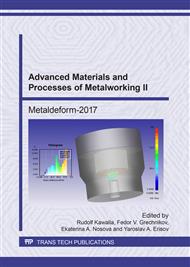p.184
p.192
p.201
p.207
p.214
p.219
p.235
p.240
p.246
Metal Forming Aspects of Cyclic Severe Plastic Deformation of Ti-Ni Shape Memory Alloys Using MaxStrain Device
Abstract:
The effect of severe plastic deformation using MaxStrain (MS) device which is a part of the Gleeble thermo-mechanical simulator of rolling and forging processes on the structure and functional properties of Ti–50.0 at.% Ni shape memory alloy has been studied. The use of the MS module allows performing SPD of the material under isothermal conditions with precise control of the deformation parameters. The deformation temperature was lowered from 370 to 330 °C. The accumulated true strain varied from e=4.6 to 9.5. Structure features were studied by the transmission electron microscopy. The maximum completely recoverable strain was determined by a thermomechanical method using a bending mode for strain inducing. A mixed submicrocrystalline and nanosubgrained structure with average grain/subgrain size below 100 nm was formed using SPD at 330 °C. A very high completely reсoverable strain (9.3%) was obtained against a reference treatment (2.5%).
Info:
Periodical:
Pages:
214-218
Citation:
Online since:
July 2017
Price:
Сopyright:
© 2017 Trans Tech Publications Ltd. All Rights Reserved
Share:
Citation:


